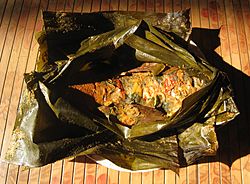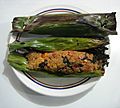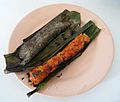Pepes facts for kids

Carp fish pepes
|
|
| Alternative names | Pais (Sundanese) |
|---|---|
| Course | Main course |
| Place of origin | Indonesia |
| Region or state | Nationwide |
| Serving temperature | Hot or room temperature |
| Main ingredients | Various ingredients (fish, meat, mushroom, tofu or oncom) spiced and cooked in a banana leaf |
| Variations | Buntil, Botok, Otak-otak |
Pepes is a special way of cooking from Indonesia. It uses banana leaves to wrap food before it's cooked. Imagine wrapping your meal in a natural package! This package is tied with a small stick, then it's either steamed or grilled over hot coals.
This cooking method helps all the yummy spices soak into the food. It also gives the food a unique, smoky smell from the banana leaf. Even though the banana leaf is used for cooking, you don't eat it. You unwrap your food and enjoy!
Contents
What's in a Name? The Story of Pepes
The cooking style using banana leaves is popular all over Indonesia. It has many different names depending on the local language. For example, it's called pais in Sundanese. In Javanese, it's known as brengkesan.
The common Indonesian name pepes comes from the Sundanese word papais. This word is the plural form of pais. Because this cooking method first became very popular through Sundanese food, pepes is often linked to Sundanese cuisine.
Delicious Pepes Variations
While fish is a very common ingredient for pepes, it's not the only one! You can make pepes with many different foods. This includes seafood, chicken, and even vegetables.
Popular Fish Pepes
Many types of fish are used to make pepes. In West Java, ikan mas (which is a type of Eurasian carp) is a favorite. In Palembang, people often use patin or lais fish. Over in West Sumatra, bilih fish is a popular choice.
Beyond Fish: Other Pepes Ingredients
Besides fish, you can find pepes made with other seafood like shrimp or squid. Chicken and even minced beef mixed with egg can also be used. For those who like plant-based options, tofu, tempeh, oncom, or mushrooms are great choices.
There are many unique pepes recipes. For example, in Palembang, there's pepes tempoyak. This is a steamed paste made from fermented durian fruit, wrapped in a banana leaf.
Different Kinds of Pepes Dishes
Here are some examples of different pepes dishes you might find:
- Pepes ikan mas (carp fish pepes)
- Pepes daging (minced beef pepes)
- Pepes ayam (chicken pepes)
- Pepes tahu (tofu pepes)
- Pepes oncom (oncom pepes)
- Pepes teri (anchovy fish pepes)
- Pepes jamur (mushroom pepes)
- Pepes tempoyak (fermented durian paste pepes)
Pepes dishes are usually eaten with warm, steamed rice.
Dishes Similar to Pepes
- Otak-otak: This dish is similar to pepes. It's a mix of fish and tapioca flour with spices. It's also wrapped in a banana leaf.
- Botok: This is a vegetable dish with shredded coconut. It's cooked in a similar way to pepes.
- Buntil: This dish uses papaya or cassava leaves instead of banana leaves. The wrapping is eaten as part of the dish.
How Pepes is Made
Making pepes starts with mixing your main ingredient, like fish, with a lot of flavorful spices. These spices often include salt, chilli, shallots, garlic, turmeric, ginger, lemongrass, and tomato. Other common additions are candlenut and lemon basil.
Once everything is mixed, it's carefully wrapped in a banana leaf. The leaf is folded tightly and secured at both ends with a small stick. Then, the wrapped package is either steamed or grilled.
In Sundanese cooking, there are two main types of pepes. One is the regular or "plain" kind. The other is "yellow pepes," which gets its color and flavor from turmeric. If you want to make fish pepes with very soft bones, people sometimes use a pressure cooker or cook it for a very long time.
Images for kids
See also
 In Spanish: Pepes (Indonesia) para niños
In Spanish: Pepes (Indonesia) para niños







